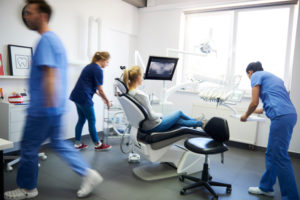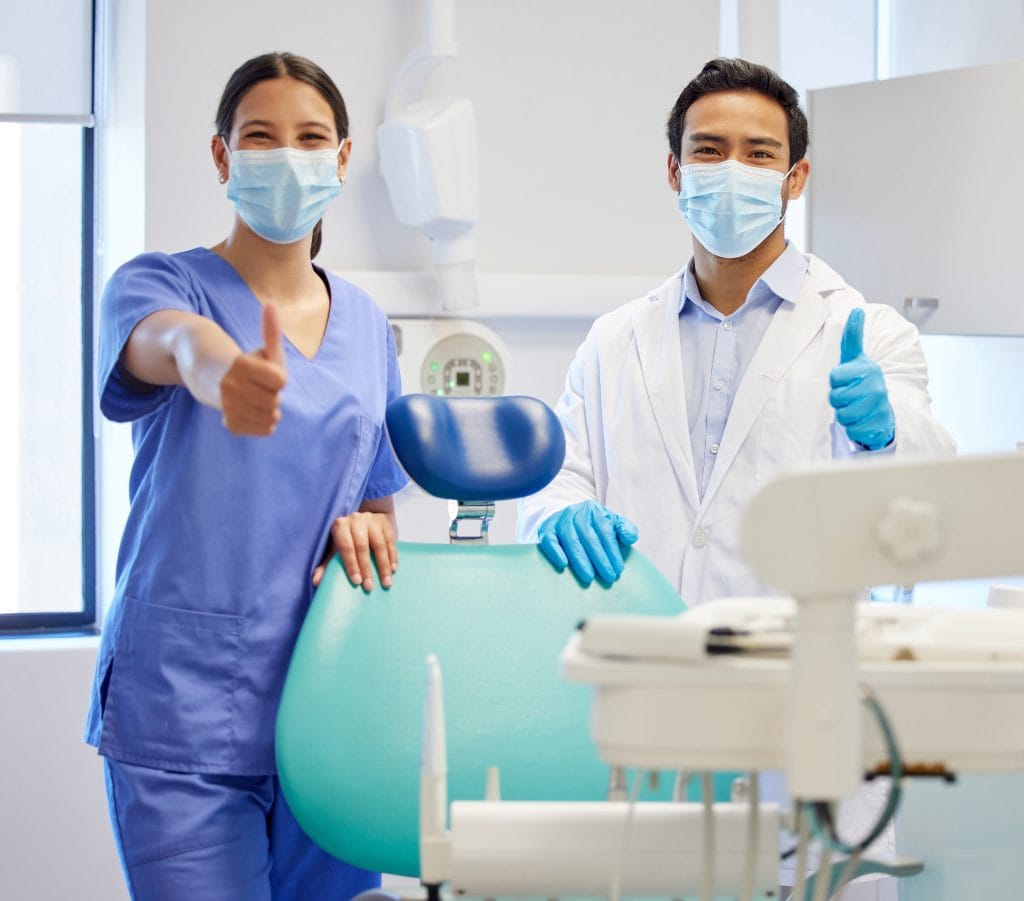Last updated on March 15th, 2023 at 01:59 pm
 There’s often a division between the front office and the back office. And while this isn’t an issue in every dental office, I’ve seen it enough recently that I’d like to bring it up.
There’s often a division between the front office and the back office. And while this isn’t an issue in every dental office, I’ve seen it enough recently that I’d like to bring it up.
The “front” does their thing, the “back” does their thing—and neither are very familiar with the activities and frustrations of the other. And it can create a little rivalry and argumentativeness.
The front wants to schedule a person here, but the back says it can’t be done. The front is trying to figure out how to meet production numbers, so they schedule them anyway. The back is trying to figure out how to treat the patient properly, so they get mad.
(Related: 6 Mistakes That Dental Front Offices Make)
So how do you improve coordination and get everyone on the same page?
 The essence of the problem is that you have two separate teams working independently of each other—or at worst, actively working against each other.
The essence of the problem is that you have two separate teams working independently of each other—or at worst, actively working against each other.
(Related: Front Office vs. Back Office)
You need ONE team all working together. And the primary ways you do that are:
- Uniting everyone toward a common purpose.
- Having open and good communication
- Coordinating with each other on a regular basis
So, let’s cover how to do each of those things:
1. Uniting everyone toward a common purpose
This is what a team is: people working together to achieve the same purpose. And the purpose in a dental office is to service the patients in your community, eradicate disease, and get them healthy.
The back office contributes to this purpose by performing (or assisting in performing) treatment on patients. The front office contributes to this purpose by getting patients into the practice and ensuring everything is taken care so that they can receive that treatment.
The enemy here, if there was one, would be dental disease. The enemy is not each other.
(Related: 4 Tips for Hiring Great Front Office Staff)
So, the first thing that needs to happen is everyone needs to take a big step back and realize that this is one team. Get everyone together and reorient them to the purpose of the practice. And despite all the new requirements, that is still WHY you’re all there! Make sure everyone understands how their job—and everyone else’s jobs—contribute to that purpose. And when everyone does that job well and coordinates well, it makes their own jobs easier.
2. Having open and good communication
 Hold a meeting where everyone can talk to each other and gain understanding of what each other are doing and the issues they are running into.
Hold a meeting where everyone can talk to each other and gain understanding of what each other are doing and the issues they are running into.
BUT we don’t want this to turn into a big, nasty argument where everyone yells at each other about what they’re doing wrong.
(Related: Improving Staff Initiative in the Dental Office)
So before the meeting commences, you’re going to:
- Explain why you’re having the meeting
- Go over the purpose (as covered in point #1 above), and
- Ensure everyone understands that this meeting isn’t to point fingers at each other. It’s to work together and come up with solutions that help everyone, as well as promoting awareness of what’s changed on each team member’s position as a result of any new requirements.
3. Coordinating with each other on a regular basis
Your morning huddle every day is your time to get the whole team coordinated. And an effective morning huddle is one of the most important things you can do to increase daily production and make the practice run efficiently.
The front and back office staff should be there to look at the schedule for the day, any changes that need to be made or openings filled, and which patients have outstanding treatment that needs to be accepted and scheduled.
(Related: Seven Steps to a Well-Trained Staff)
If you do your morning huddle right, then there won’t be anything to argue about throughout the day. Everyone will know what needs to be done and how.
The full format for effective morning huddle is outlined in this post and a video course is available on DDS Success, our on-demand online platform. You’ll find it in the Teambuilding Sessions. I highly suggest watching that together as a group. There’s a lot that goes into a good huddle (which most dental offices don’t do) but that doesn’t mean it should be long—it should be a very quick, efficient meeting.
A few additional points
 I do have a couple more pieces of advice.
I do have a couple more pieces of advice.
In the past, I’ve recommended having front office employees do some assisting in the back, and for back office staff to come up front for a few days. Obviously, this isn’t going to work right now in the aftermath of COVID-19. You’ve got too much going on to start experimenting and changing people’s jobs.
But this is still a good idea for the future when things start returning to normal. It gives everyone an understanding of how things work and will make the schedule run a lot more smoothly.
And lastly, if you’d done the things I mentioned above—reorient everyone to the purpose and get open communication and coordination—and someone still can’t work well with their teammates, then they just may not be a good fit for your practice.
You need a team that cares about helping your patients, works well together, and positively contributes to the practice environment. If they can’t do that and keep fighting with other staff, then keeping them on board may be hurting the rest of your team, your patients, and overall practice productivity. So, if you find yourself in this situation, better to evaluate it now, rather than later.
I hope this helps! Obviously the best answer to all of this is team training. And nowadays that’s easier than ever, because here at MGE we’ve made 60% of our education and coaching services available online. You could attend our live course training and utilize our on-demand team training platform, DDS Success.
And if you need any help, schedule a free consultation here.



No Comments
Be the first to start a conversation